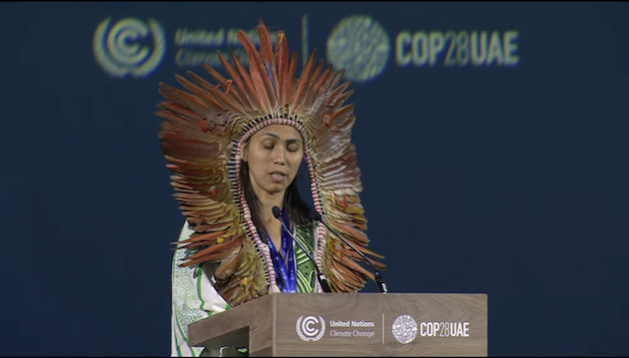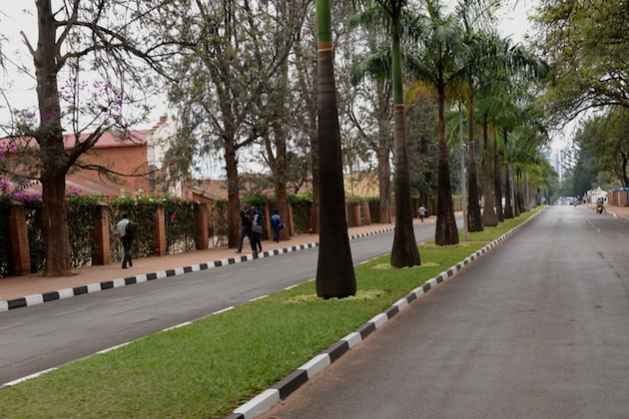Creator and Web page data
- This web page: https://www.globalissues.org/article/805/cop20-lima-climate-conference.
- To print all data (e.g. expanded facet notes, exhibits different hyperlinks), use the print model:
On this web page:
Introduction
 December 1 – 14, 2014, Lima, Peru was the venue for the twentieth annual United Nations Local weather Change Convention, also called the twentieth Convention of the Events — or COP 20.
December 1 – 14, 2014, Lima, Peru was the venue for the twentieth annual United Nations Local weather Change Convention, also called the twentieth Convention of the Events — or COP 20.
The aim of this convention was to create a common settlement on local weather change motion and start the method of financing mitigation.
Assembly end result
The assembly ended with all nations agreeing to chop again greenhouse gasoline emissions. Often called the Lima Accord, this treaty just isn’t legally binding and nations should not have to specify how a lot they may in the reduction of, as an alternative agreeing to report their plans again by March 2015.
Whereas for a lot of it seemed like a profitable end result, others had been upset, similar to poor nations struggling to rebuild from present impacts of local weather change who had been alarmed on the disappearance of loss and harm commitments from the ultimate textual content which has been a part of the dialogue for years.
The worldwide local weather motion, 350.org, summarized the disappointments and hopeful features of the assembly end result, noting
- The brand new settlement doesn’t replicate the urgency of the local weather disaster
- Some good agreements – however no measures to make sure implementation
- Least developed and susceptible nations unnoticed within the chilly
- Divestment (from fossil gasoline reliance) is extra necessary than ever
- International momentum for actual options is stronger than ever and can carry on going.
In attempting to place a optimistic spin on the general disappointment they felt, they concluded, In the long run, a worldwide local weather treaty is only one instrument to fight local weather change. Actual change goes to proceed to come back from the grassroots. The UN Local weather Talks proceed to be a spot the place the world’s nations comes collectively to debate this disaster and persons are placing in monumental efforts to ensure Paris [the next global meeting] received’t be like Copenhagen
which was stuffed with disappointments regardless of large guarantees.
Samantha Smith, Chief of WWF’s International Local weather and Vitality Initiative, was fairly scathing of the assembly end result saying that political expediency received over scientific urgency
. She additionally famous that Developed nation governments couldn’t even handle to elucidate how they may ship the long-promised US$100 billion per 12 months in local weather finance by 2020. In a transfer that seemingly dismissed the plight of probably the most susceptible nations, they utterly eliminated any significant language about ‘loss and harm’.
Mainstream media reporting
As with virtually each earlier assembly (with occasional exceptions), mainstream media reporting was very poor given the significance of this world situation. The place the assembly was reported it was typically in direction of the tip, and simply sound chunk kind summaries saying all nations agreed to emission cuts and that this was a significant enchancment.
Whereas the treaty continued to say it honors the long-standing frequent however differentiated obligations
the mainstream media reporting (as in most years) has sometimes failed to offer rationalization and context of this precept that has been an necessary a part of these talks for over 2 a long time; that poor and creating nations mustn’t bear the identical obligations because the developed ones (as a result of they don’t seem to be the reason for the anthropogenic carbon emissions over the earlier a long time which have led to this, which is detailed way more on this website’s web page on local weather justice).
A touch in direction of this precept might have been introduced as a viewpoint of China or India, given the impression they’re being obstacles, fairly then explaining this precept in additional context.
That was simply one of many points skirted over or omitted from frequent reporting. Others included points on financing, know-how help for poorer nations, and so forth. Behind the scenes, for many years, wealthy nations have stalled on this stuff or actively averted attempting to share know-how and so forth, which is barely reported.
Yearly, this criticism is manufactured from mainstream reporting, so with out following these negotiations annually, it may be straightforward to come back away with the impression that this assembly had a optimistic end result.
However as this dialogue hosted by Democracy Now! exhibits, there have been numerous necessary problems with rivalry:
In context: frequent however differentiated obligations
A few years in the past all nations agreed that local weather change was largely the results of actions from right this moment’s industrialized nations, as carbon dioxide — the principle greenhouse gasoline — stays within the ambiance for many years. But, the poorest would find yourself struggling probably the most for an issue they largely didn’t trigger. The approaches to mitigation (emissions discount) would due to this fact be totally different for these teams of nations — the frequent however differentiated obligations precept.
It’s on this context that the dialogue for loss and harm has come about. And it’s one thing that wealthy nations are eager to eliminate .
The years of resistance on this situation (and lots of others) means every time it’s mentioned once more the reactions appear to get much more hostile. Mixed with the shortage of detailed context within the mainstream media protection of this facet, it then turns into simpler every time to see culprits as China and India given their monumental greenhouse emissions lately, in comparison with the far larger quantity by the industrialized nations over the longer interval. See this website’s part on local weather justice for extra detailed background.
And as this website has stated for years on the local weather justice web page, the wealthy nations are delaying any significant motion till it’s ultimately — and disproportionately — paid for the by the creating nations. New Delhi based mostly Nitin Sethi, affiliate editor at Enterprise Customary, interviewed within the earlier talked about video says the identical factor, however extra frankly:
There isn’t a motion that’s going to occur between now and 2020. All of that was to be carried out by the developed nations. They [rich nations] principally have simply stated at Lima that
we’re not going to do any greater than what we’re doing thus far, and the burden can shift onto the post-2020 period, the place different creating nations need to share it.So, to me, it signifies actually negotiation in unhealthy religion.
Extra data
Because the convention remains to be underway as this web page is written, extra data will probably be added right here after the occasion is over.
For extra concerning the points from different organizations, listed below are some beginning factors:
Information tales from IPS
Under is an inventory of tales from Inter Press Service associated to the Lima local weather convention and its aftermath.
-
Peru’s Andean Peoples ‘Revive’ Water that the Local weather Disaster Is Taking From Them
– Inter Press Service

CUZCO, Peru, Dec 18 (IPS) – Earlier than, when it did not rain within the summertime, we kids used to hope to God to ship us water from the heavens, and the rain would come. However now it is totally different; the local weather has modified and no prayers work—Juan Hilario Quispe, president of the small farming neighborhood of Muñapata
“The wealthy world has prompted the local weather change that’s drying up our water sources, and right here we’re doing all the things we will to recuperate them as a result of in any other case we’ll die,” stated Juan Hilario Quispe, president of the small farming neighborhood of Muñapata, simply over 50 kilometers from the Peruvian metropolis of Cuzco. -
IFAD’s Report-Breaking Pledges: Lifeline for Rural Communities Cornered by Local weather, Starvation
– Inter Press Service

NAIROBI, Dec 15 (IPS) – The world just isn’t on observe to finish starvation and poverty as a way forward for rising meals insecurity and local weather challenges beckon. Small-scale farmers are the spine of meals manufacturing, producing one-third of the world’s meals and as much as 70 % of the meals consumed in Africa and Asia, but they’re typically reduce off from the companies they should pull themselves out of poverty and meals insecurity.
-
INTERVIEW: ‘Local weather of division’ creating more difficult setting for UN peacekeeping
– UN Information

UN peacekeeping missions in Sub-Saharan Africa are working beneath more difficult political and safety circumstances because of a multiplication of crises and a “local weather of division” amongst Member States, significantly within the Safety Council. That’s based on the pinnacle of UN Peacekeeping, Jean-Pierre Lacroix.
-
Its Time To Align Local weather Finance and Social Justice, Says Youth Local weather Activist
– Inter Press Service

DUBAI, Dec 12 (IPS) – Joshua Amponsem, co-director of the Youth Local weather Justice Fund, believes it’s time to guarantee local weather finance and social justice points are elevated to the highest of the agenda and negotiations at COP28.
-
Local weather advocates demand stronger COP28 language on fossil fuels
– UN Information

The newest COP28 draft end result textual content launched to negotiators in Dubai Monday night dropped a name to ‘phaseout’ fossil fuels, prompting outcry from local weather susceptible nations and civil society.
-
Local weather Justice is the Duty of the Wealthier Nations, Says Bangladesh Local weather Envoy
– Inter Press Service

DUBAI, Dec 11 (IPS) – Wealthier nations should ship the funds so creating nations can adapt—the time for excuses is over, says Saber Hossain Chowdhury, Bangladesh’s Particular Envoy for Local weather Change within the Prime Minister’s Workplace.
-
Greening Training: Training Paying Highest Price for Ongoing Local weather Disaster
– Inter Press Service

DUBAI, Dec 09 (IPS) – It’s a world disaster of astounding proportions that tens of millions of kids are on the run right this moment, forcibly displaced from their houses. As battle and local weather change more and more develop into probably the most urgent challenges dealing with the world now, the variety of displaced kids has doubled within the final decade alone, reaching a report excessive of 43.3 million kids.
-
For Africans, the Local weather Debate Across the Position of Livestock Misses the Mark
– Inter Press Service

NAIROBI, Kenya, Dec 08 (IPS) – Africa is contending with a local weather disaster it didn’t create with out adequate recognition for the distinctive rights and wishes of the world’s youngest and fastest-growing inhabitants. Not solely is the continent least accountable for decreasing greenhouse gasoline emissions, having traditionally produced only a tiny fractionhowever additionally it is disproportionately impacted by the implications of emissions generated elsewhere.
-
Why Local weather Justice and International Monetary Reform Are Inseparable
– Inter Press Service

DUBAI & DOMINICA, Dec 08 (IPS) – An award-winning worldwide improvement professional and a local weather justice professional have referred to as for a rethink of the worldwide monetary system that will carry reparatory justice to small, climate-vulnerable nations whereas providing concessionary improvement financing to the nations most in want of help.
-
Our voices and wishes have to be put first in local weather talks, younger folks inform COP28
– UN Information

Younger local weather advocates at COP28 in Dubai on Friday stated they won’t sit idly by whereas local weather change threatens their futures. They demanded that authorities policymakers put the wants of the world’s almost 2 billion kids first – their voices and concepts may help rescue the planet.
-
Religion Pavilion Provides Religious Dimension to Local weather Disaster Decision
– Inter Press Service

DUBAI, Dec 07 (IPS) – For the primary time at COP28, religion has a pavilion alongside science, know-how, nations, and philanthropy, permitting non secular leaders from everywhere in the world to debate the potential for utilizing non secular deserves to guard the earth from local weather change.
-
COP28: Local weather Migrants Rights, Danger-based Labor Polices Below the Highlight
– Inter Press Service

DUBAI, Dec 07 (IPS) – With COP23 underway, researchers and activists are pointing on the plight of local weather migrants.
-
COP28 is about motion, not politics and level scoring, says UN local weather chief
– UN Information

UN local weather chief Simon Stiell stated on Wednesday that COP28 delegates aren’t in Dubai to “rating factors” and play at “lowest-denominator politics”; they have to take bold motion on curbing world warming and ending the local weather disaster.
-
Rising Local weather Finance Infrastructure to Match Africa’s Inexperienced Bankable Options
– Inter Press Service

DUBAI, Dec 06 (IPS) – Though lengthy profiled because the face of local weather change, a high-risk continent with a pipeline of unbankable inexperienced tasks, there are areas the place Africa is main the world. The 1987 unintentional discovery of the primary deposit of pure hydrogen throughout a water drilling marketing campaign in Bourakebougou village, Mali, is right this moment proving that Africa can export viable inexperienced options.
-
The Local weather Disaster is an Training Disaster
– Inter Press Service

London/New York, Dec 05 (IPS) – “The one worldwide language the world understands” wrote Eglantyne Jebb, founding father of Save the Kids, “is the cry of a kid,” and the proof is accumulating that kids aren’t solely the harmless victims of battle whose pleas have to be heard, but additionally probably the most susceptible victims of local weather change.
-
Why the UN COP28 Local weather Talks Should Serve Farmers to Obtain a Simply Transition
– Inter Press Service

DUBAI, Dec 05 (IPS) – Meals and agriculture is a prime agenda merchandise at UNFCCC COP28because the world considers how you can sort out the local weather impacts of what we eat and the way we produce it. The stage has been set for COP28 to be a “meals COP”, however for commitments to translate to motion, it should even be a “farmers’ COP”.
-
Ten African Nations to Profit From USD 100 Million Launched by Inexperienced Local weather Fund
– Inter Press Service

DUBAI, Dec 05 (IPS) – The Inexperienced Local weather Fund (GCF) has introduced the discharge of USD 100 million on the ongoing United Nations Framework Conference on Local weather Change (UNFCCC) twenty eighth Convention of Events (COP 28) in Dubai, UAE, to help 10 African nations in adapting meals loss discount options.
-
COP28: Tuesday’s local weather motion in Dubai
– UN Information

The UN local weather convention will proceed its work on Tuesday specializing in points that embrace scaling up financing for the Paris Settlement, slashing emissions within the cooling sector, making certain a local weather resilient power sector and a dialogue with indigenous peoples.
-
A Local weather Scientist’s View of COP 28
– Inter Press Service

STOCKHOLM, Sweden, Dec 04 (IPS) – This 12 months’s UN Local weather Change Convention is happening in Dubai from 30 November to 12 December. The so-called COP summits are organised yearly and represent a method for the worldwide neighborhood to agree on methods to deal with the local weather disaster, similar to limiting world temperature rise to 1.5 levels Celsius, supporting susceptible communities to adapt to the results of local weather change, and attaining net-zero emissions by 2050.
-
COP28: Carry the susceptible to ‘entrance of the road’ for local weather funding
– UN Information

Advocates showcased the devastating impacts of local weather upheaval on their communities at COP 28 on Monday as the main target of the world’s largest local weather gathering turned to monetary help for these most in danger – at the start youth and ladies in creating nations.
-
COP28: Girls and local weather advocates driving ahead change collectively
– UN Information

To fight the disproportionate impacts of local weather change on girls, advocates at COP28 on Monday stated decisionmakers should not solely enact extra polices that meet their particular wants however acknowledge the distinctive data and experience girls can provide that can be utilized to help efficient local weather motion.
-
COP28: Methane pledge by the ‘giants behind the local weather disaster’ falls brief, says Guterres
– UN Information

UN Secretary-Basic António Guterres on Sunday despatched a powerful message to the oil and gasoline business: the pledges made at COP28 in Dubai fall nicely in need of what’s wanted to meaningfully sort out the local weather disaster.
-
COP28: The local weather disaster can also be a well being disaster
– UN Information

Well being has made it onto the agenda of a UN local weather convention, and well being advocates at COP28 in Dubai on Sunday stated the subject was lengthy overdue for dialogue as local weather inaction is costing lives and impacting well being each single day.
-
Why is There Funding for Struggle However By no means for Local weather finance, Ask Feminists
– Inter Press Service

DUBAI, Dec 02 (IPS) – The Feminist Inexperienced New Deal Coalition has highlighted feminist local weather options and shared feminist insurance policies and frameworks which can be advancing simply local weather insurance policies on the United Nations Framework Conference on Local weather Change (UNFCCC) twenty seventh session of the Convention of Events (COP28) in Dubai.
-
Tackling well being impacts of local weather change and scaling up digital local weather motion within the highlight at COP28
– UN Information

Delegates at COP28 in Dubai on Saturday referred to as for stronger and extra resilient world well being methods, that are indispensable to defending populations from the unfavorable impacts of local weather change on well being.
-
Local weather Change Not Simply One other Concern in Your Inbox, Leaders instructed
– Inter Press Service

DUBAI, Dec 1 2023 (IPS) – United Nations Secretary-Basic António Guterres stated world leaders wanted to urgently commit to 3 methods: reduce emissions, speed up a simply, equitable transition to renewables, and to local weather justice.
-
Restoring Indigenous Bushes: New Mission to Fight Local weather Change in Rwanda
– Inter Press Service

KIGALI, Dec 01 (IPS) – With the continued nationwide tree-planting marketing campaign, Rwanda seeks to switch its degraded forest ensuing from charcoal manufacturing and firewood and improve the necessity for development supplies with new indigenous timber to fight local weather change.
-
International agrifood methods are the local weather resolution, new FAO report highlights
– UN Information

Agrifood methods and the communities that help and rely on them are on the entrance strains of loss and harm linked to local weather change, a brand new report launched on Friday by the UN Meals and Agriculture Group (FAO) has revealed.
-
Science factors to ‘local weather collapse’ as UN chief calls COP28 to motion
– UN Information

The world is heating up at an unprecedented tempo, new local weather information exhibits, and leaders gathered for the COP28 convention which opened in Dubai on Thursday should get us out of “deep bother”, UN chief António Guterres stated.
-
Local weather change dangers upending world combat in opposition to malaria
– UN Information

Local weather change and its impacts, significantly excessive climate and heatwaves, pose a “substantial danger” to progress being made to combat malaria, the UN World Well being Group (WHO) stated on Thursday.
Creator and Web page Info
- Created:

